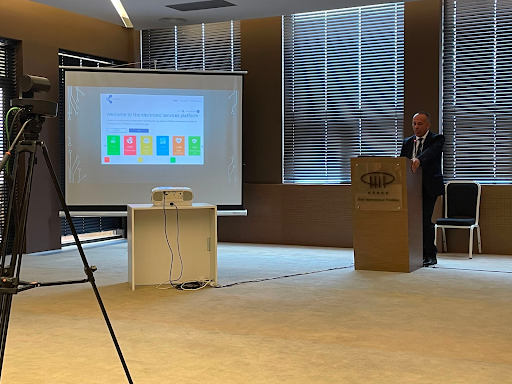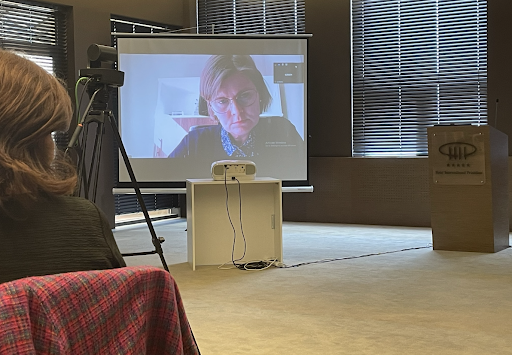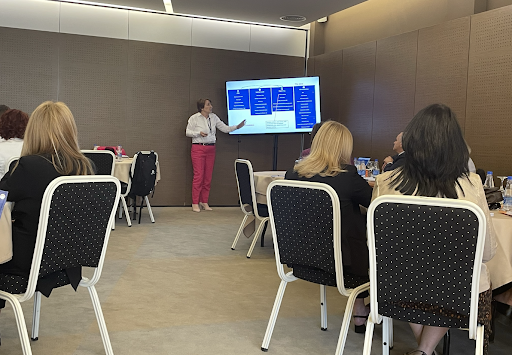In May, some of the team behind the Digital Public Finance Hub at ODI and Public Digital were lucky to be in Pristina, Kosovo for a conference on digital public financial management, organised by CIPFA and the Center of Excellence in Finance.
The one-day conference was a convening of European public finance professionals, primarily from governments in the western Balkans. The day was structured around case studies of digital PFM reform in countries, with presentations from officials in Kosovo, Ukraine, Estonia, and Bosnia and Herzegovina.
Digital Transformation of PFM in Kosovo
The day began with a scene-setting session led by Jeton Beqiri, the IT advisor to the minister of finance, labour and transfers of Kosovo. The session focused on a broad overview of how the government thinks about digital PFM reform, highlighting some of the strategic thinking that goes into optimising the digital architecture for PFM, both on the back end and through front-facing service delivery via e-Kosova.
The government has pursued this more joined-up view of digital PFM by embedding change in the decisions of senior leadership, in order to both (a) make the digital transformation of PFM itself more sustainable, and (b) clarify how PFM strategy fits within broader goals. Beqiri highlighted how the government has gone about deliberately consolidating and connecting various information systems, as well as reorganising the institutional architecture and hierarchies needed to strengthen PFM decision-making.
The session made a good case for how a more holistic focus on PFM reform and digital transformation (a key theme highlighted in ODI/Public Digital’s recent paper on digital PFM) can result in more intentional thinking about connecting PFM reform and public sector digital transformation to deliver service and efficiency benefits.
E-Auctioning in Ukraine’s ProZorro.Sale
The next session was facilitated remotely from Ukraine by Ilia Mikhailov, one of the leads of Prozorro.Sale, a new open-source solution for e-auctioning of public and private assets. The session highlighted the trajectory of ProZorro.Sale.
Since its inception in 2019 – a time of economic turmoil in Ukraine – its stated goal was to create a transparent e-auction platform that democratised sale of assets away from the ‘right’ people and focused on building trust in the Ukrainian government, in order to strengthen accountability and transparency at a time when public faith in government was low.
In the past four years, the platform helped facilitate the sale of state assets such as property leases, buildings, non-performing loans, timber, railway cars and mineral extraction rights. Mikhailov highlighted many ways in which ProZorro.Sale is improving public expenditure and revenue flows while also helping to facilitate market transformation across the Ukrainian public sector and economy, with a view towards its implications for trust PFM.
For example, Mikhailov highlighted how digitalisation, transparency, and trust are the key principles behind the system, and how opening up transactions for everyone to see was a key way of building trust more broadly – with the technology being the key enabler itself. The session provided a good example of how technology reform itself can help drive digital reform by changing the culture, processes, and operating models of government.
Digitalising the Budget Cycle in Estonia
The first of two breakout sessions focused on the case of digitalising the budget cycle in Estonia. Ines Metsalu-Nurminen from the National Audit Office of Estonia (‘Riigikontrol’) gave an overview of some of the mechanics behind the process of digitalising Estonia’s budget cycle. The session focused on key learnings from how the government has approached digital PFM in comparison to other aspects of digital government modernisation (which Estonia is quite renowned for).
It started with a broad overview of Estonia’s experience with e-government and digital transformation over the past 10-20 years, which was surely helpful for PFM professionals in the room, not all of whom were deeply steeped in the concepts behind digital transformation. The session continued into an overview of the budget cycle in the context of Estonia’s approach to digital public infrastructure, including the X-Road data exchange and once-only principle for data collection.
The conversation included some candid reflections on the challenges of performance-based budgeting in Estonia, mainly on the basis of the ability to share and link financial and non-financial data between different ministries. Mesalu-Nurminen also overviewed some of the difficulties they have had in optimising PFM to pull timely data for financial reporting and auditing. In this way, the session highlighted the importance of the legal framework and sound basics for PFM, even when there are strong fundamentals of digital government modernisation and digital service delivery in place.
Digitalisation of Risk Management and Auditing Functions in Bosnia and Herzegovina
The second breakout session of the day was facilitated by independent consultant Vania Tomeva and Danijela Stepic from the Ministry of Finance of Croatia. Composed of two presentations, the session was a deep dive on PFM reform in the context of risk management and auditing functions of finance ministries – a key part of the PFM lifecycle.
The session focused on the implementation of a Public Internal Financial Control (PIFC) application – a digitalised risk management system developed within the Ministry of Finance in BiH – focused on the potential for centralised risk intelligence as a way of improving PFM decision-making. It also discussed in-depth the open-source nature of the code and technology application, and how it could be shared across borders with other governments.
The benefits of PFIC implementation are largely based around the standardisation of data and processes (e.g. codebooks, registers of institutions, lists of financial controls) for harmonised reporting, as well as how consistent implementation and enforcement of the rules and norms around those data and processes can reduce the administrative burden of financial risk assessment and reporting.
The session made clear that PFM varies widely depending on the legal frameworks in place for financial auditing and reporting. Indeed, systems like these highlight how context-specific and harmonised risk controls can enable more coherence in PFM, as well as help governments manage financial risk overall.
Cross-cutting themes
Each of these case studies demonstrates tangible examples of how digital PFM reform is happening in practice. They also point to some of the trends we are observing in the expanding practice of digital PFM. In order to make this point clearer, we wanted to highlight some key themes from the conference.
1. Interoperability and registers are a key way of providing a ‘single source of truth’ for PFM across government
We observed across each of the presentations that making data more readable and usable is emerging as one of the ultimate goals of digital PFM reform. In many ways, the legibility of data and ability to use data across ministries and agencies must influence decision-making, but the duplication of datasets makes it difficult to do this.
Most PFM software is built on lists of registries, and the consolidation of those lists makes (financial) data interoperability easier, in support of PFM decision-making. In this way, there is a critical need to have a ‘single source of truth’, in order to make performance-based budgets and analysis of PFM outcomes more transparent and robust, and to support use cases across the PFM lifecycle.
2. Organisational hierarchies in PFM are highly determinative of outcomes
The practice of PFM is, more than many public sector disciplines, bound by the constraints of the organisations in which it operates. For this reason, strategy and organisational hierarchies are key to understanding how PFM monitoring plays out in sectors across government.
Increasingly, there is a need to streamline governance around broader digital transformation reform proposals in order to increase focus on both outcomes and user experience, which should provide a better starting point for PFM decision-making. Moreover, a focus on improving outcomes for citizens and businesses can guide PFM policy across sectors, rather than simply focusing on optimisation of PFM tools and processes for administrative reform.
3. Fragmentation of solutions across systems and platforms demands more shared, foundational approaches
Due to generally solution-driven approaches, many governments struggle with the persistence of fragmented systems across government. This is partly because – regardless of licensing – many of the solutions used in PFM (software, standards, information systems, etc.) tend to be developed in a bespoke manner, either in-house, with vendors, or in some combination of these two.
Furthermore, many solutions have had discrete success. It is often difficult to transfer knowledge about them or to even port them over wholly towards other contexts, and there remains some scepticism of open-source software in particular.
Through the conference, we have begun to observe some demand for common platforms and standards to remediate some of these challenges, though it is clear that PFM remains constrained by solution-driven thinking.
4. Accountability and transparency is key for PFM reform
There is a high level of correlation between trust in government and the presence of accountability and transparency mechanisms in PFM. Many of the presentations highlighted this reality, showing how the technology itself can help shape how the government responds to and reflects the legal frameworks for financial transparency in which they operate.
In this context, digital transformation in the space offers a huge opportunity to open up the scope of what is possible. By thinking about the interrelationships between technology, funding, delivery, and strategy, we can begin to think about how the government can use PFM as a way to rebuild trust in one of the critical capabilities of government: managing public finance efficiently and equitably.
Thank you for reading this far, and for taking the time to learn more about the conference. If you have any feedback or would like to learn more, please reach out to [email protected] or [email protected].

















